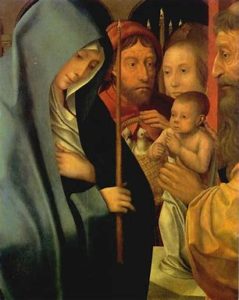February 2; since the sixth century the day of the Feast of the Purification of the Blessed Virgin Mary and now known as the Feast of the Presentation, marking the ritual in the Temple required by Jewish law law forty days after the birth of a male child.
When the infant Jesus was brought to the Temple, Simeon spoke of him as “a light to lighten the Gentiles” (Luke 2:32) and so light is the theme of the day. Believers bring a candle to the church to be blessed; these candles are thought to possess magical powers against sickness and thunder storms. Across many cultures it is the last day of the Christmas season when all ornaments must be taken down and greenery burnt. In England the Yule log for the next Christmas was selected and set to dry; in Mexico it is the Dia de Candelaria when the image of the baby Jesus is removed from the cradle. On Candlemas, Scottish school children used to bring money to their teacher to buy candles to light the school room, a practice that turned into simply bringing gifts to the master. The boy who brought the most money (the term for this gratuity was bleeze-money) was named Candlemas King whose reign lasted six weeks and who was allowed to remit punishments.
The custom of predicting the weather based on conditions on Candlemas has turned into Groundhog Day wherein North Americans watch the emergence of particular groundhogs from their hibernation — if they see their shadows on February 2, six more weeks of winter will follow. (Americans scrutinize the reaction of the Pennsylvania groundhog named Punxsutawney Phil while Canadians observe Ontario’s Wiarton Willie.) Candlemas was also believed to be a time when the soul of Judas was temporarily allowed out of Hell to ease his torment in the sea.
